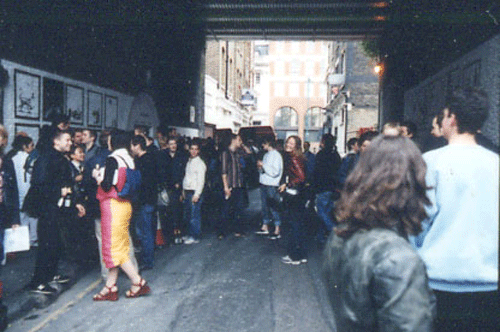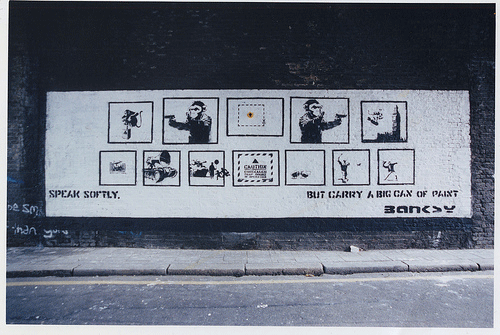- February 13, 2007
- Posted by Marc
The “Banksy Effect”


(Banksy’s first show in 2000. Nicked from Flickr here)
Two things seem to be clear:
First. That change is inevitable.
And second. That change polarizes people.
They say that things take five years to fully come into their own. And with the street art movement, we see that exactly to be the case. In truth, it wasn’t until last week’s trip to London that we fully understood how significant the changes have been in the street art scene. It wasn’t until last week that it fully hit us how much the movement has finally come into its own on so many different levels.
And one thing is clear - this has polarized a lot of people.
Coming back from London, we started explaining it to our friends as:
“The Banksy Effect”
While we’ve always been unabashed (and unapologetic) fans of Banksy, we now see Banksy as the single greatest thing that has happened not only to the street/urban art movement, but to contemporary art in general.
We know that that’s a sweepingly broad statement that is likely to get us in trouble, but let us explain.
Most people need entry points to become comfortable with things that are new.
And for millions of people, Banksy is the entry point they need in not only seeing art in a new way, but in accepting art as a part of their daily lives.
Like Andy Warhol before him, Banksy has almost single handedly redefined what art is to a lot of people who probably never felt they appreciated art before. By being an iconoclast, and in the process becoming a mythic hero for a lot of people, Banksy has become an incredible icon in our society. One that we think, when things are said and done, will be at the level of Warhol.
The fact that Banksy’s book “Wall and Piece” is in every bookstore imaginable, including Urban Outfitters, is a statement unto itself.
The fact that Banksy’s work is now selling for hundreds of thousands of dollars at Sotheby’s is a statement unto itself.
And we know that both of these things polarize a lot of people.
But for us, we think that this is the best thing that could have ever happened to the street art movement.
Why?
Because what Banksy (and Steve Lazarides) have done is to create a market for an entire category of art that until now has not been recognized at the level that it is now being recognized at.
And for this we should all be grateful.
If you’re one of those people who are calling Banksy a sellout for selling his work for exorbitant prices, but are interested in making money yourself from your own art, then you should perhaps rethink your views a bit.
Here’s what we see happening.
There are now a lot of people that have money and want to spend it on art. Their entry point into buying “urban art” is now Banksy. They read about Banksy selling his work at Sothebys and they want to be in on the action.
But not many can now afford to buy a Banksy piece any more.
This is actually a good thing for artists who are talented and want to make money from their art because those people who can’t afford “a Banksy” are now learning more and searching out and buying work from other talented artists who are part of the movement.
One of the best things that we did last week was to go to the opening of a fantastic exhibition at the Elms Lesters Painting Studios. The show featured great work by Phil Frost, Adam Neate, WK, and Anthony Lister. All four of them are incredibly talented and have been working their asses of for years. All four of them deserve everything they receive, including selling their work at prices most of us can’t afford. (We think that they deserve to make as much money as they want.)
Would the work have sold without Banksy?
Sure.
Would the show have commanded the prices it did without “the Banksy Effect”? Would the show have sold out without the “Banksy Effect”?
Some will say yes, but we don’t think so.
Of course there was a market for this movement before Banksy started selling at Sothebys. Gallerists like Jonathan Levine, Merry Karnowsky, and others have been selling art from these artists for years.
But never at the level it is selling at now.
Another sign of the Banksy effect: Prints from places like Pictures On Walls, Faile.net, and others have never sold out faster. This is allowing more artists to make a living from their art.
For us…
... Shepard Fairey created the movement.
....Banksy created the market.
And even if you don’t agree with anything we’ve just written, we do think that both of these two guys deserve the full recognition and respect for what they have done.
We think that 10 years from now, the “Banksy Effect” will be recognized as one of the most significant moments in the contemporary art market.
UPDATE: Turns out we’re not the only ones who are calling it “the Banksy Effect” Just found this CNN clip from Santa’s Ghetto here.
